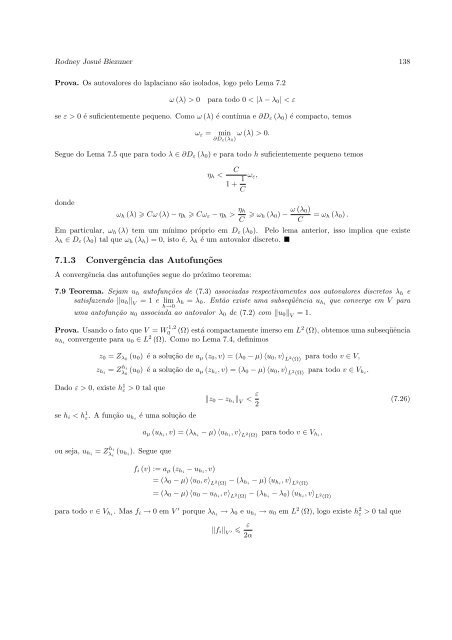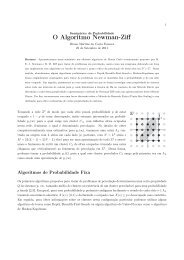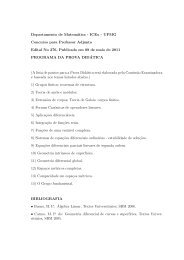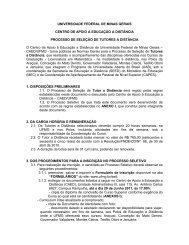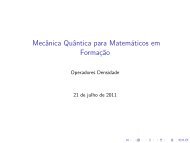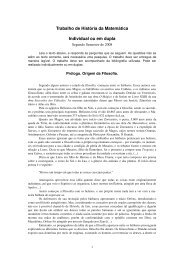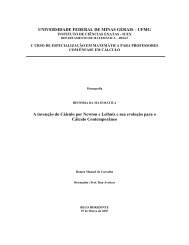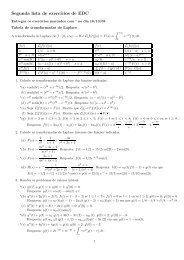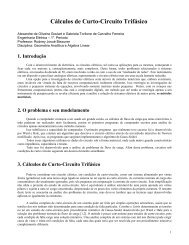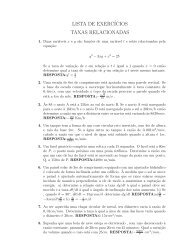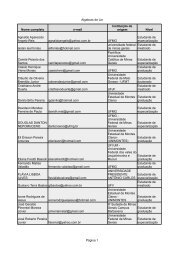Autovalores do Laplaciano - Departamento de Matemática - UFMG
Autovalores do Laplaciano - Departamento de Matemática - UFMG
Autovalores do Laplaciano - Departamento de Matemática - UFMG
Create successful ePaper yourself
Turn your PDF publications into a flip-book with our unique Google optimized e-Paper software.
Rodney Josué Biezuner 138<br />
Prova. Os autovalores <strong>do</strong> laplaciano são isola<strong>do</strong>s, logo pelo Lema 7.2<br />
ω (λ) > 0 para to<strong>do</strong> 0 < |λ − λ0| < ε<br />
se ε > 0 é suficientemente pequeno. Como ω (λ) é contínua e ∂Dε (λ0) é compacto, temos<br />
ωε = min ω (λ) > 0.<br />
∂Dε(λ0)<br />
Segue <strong>do</strong> Lema 7.5 que para to<strong>do</strong> λ ∈ ∂Dε (λ0) e para to<strong>do</strong> h suficientemente pequeno temos<br />
ηh < C<br />
1 + 1<br />
ωε,<br />
C<br />
<strong>do</strong>n<strong>de</strong><br />
ωh (λ) Cω (λ) − ηh Cωε − ηh > ηh<br />
C ωh<br />
ω (λ0)<br />
(λ0) −<br />
C = ωh (λ0) .<br />
Em particular, ωh (λ) tem um mínimo próprio em Dε (λ0). Pelo lema anterior, isso implica que existe<br />
λh ∈ Dε (λ0) tal que ωh (λh) = 0, isto é, λh é um autovalor discreto. <br />
7.1.3 Convergência das Autofunções<br />
A convergência das autofunções segue <strong>do</strong> próximo teorema:<br />
7.9 Teorema. Sejam uh autofunções <strong>de</strong> (7.3) associadas respectivamentes aos autovalores discretos λh e<br />
satisfazen<strong>do</strong> uhV = 1 e lim λh = λ0. Então existe uma subseqüência uhi que converge em V para<br />
h→0<br />
uma autofunção u0 associada ao autovalor λ0 <strong>de</strong> (7.2) com u0V = 1.<br />
Prova. Usan<strong>do</strong> o fato que V = W 1,2<br />
0 (Ω) está compactamente imerso em L 2 (Ω), obtemos uma subseqüência<br />
uhi convergente para u0 ∈ L 2 (Ω). Como no Lema 7.4, <strong>de</strong>finimos<br />
z0 = Zλ0 (u0) é a solução <strong>de</strong> aµ (z0, v) = (λ0 − µ) 〈u0, v〉 L 2 (Ω) para to<strong>do</strong> v ∈ V,<br />
zhi = Z hi<br />
λ0 (u0) é a solução <strong>de</strong> aµ (zhi, v) = (λ0 − µ) 〈u0, v〉 L 2 (Ω) para to<strong>do</strong> v ∈ Vhi.<br />
Da<strong>do</strong> ε > 0, existe h 1 ε > 0 tal que<br />
se hi < h 1 ε. A função uhi é uma solução <strong>de</strong><br />
ou seja, uhi = Z hi<br />
λi (uhi). Segue que<br />
z0 − zhi V < ε<br />
2<br />
aµ (uhi, v) = (λhi − µ) 〈uhi, v〉 L 2 (Ω) para to<strong>do</strong> v ∈ Vhi,<br />
fi (v) := aµ (zhi − uhi, v)<br />
= (λ0 − µ) 〈u0, v〉 L 2 (Ω) − (λhi − µ) 〈uhi, v〉 L 2 (Ω)<br />
= (λ0 − µ) 〈u0 − uhi, v〉 L 2 (Ω) − (λhi − λ0) 〈uhi, v〉 L 2 (Ω)<br />
para to<strong>do</strong> v ∈ Vhi. Mas fi → 0 em V ′ porque λhi → λ0 e uhi → u0 em L 2 (Ω), logo existe h 2 ε > 0 tal que<br />
fi V ′ ε<br />
2α<br />
(7.26)


